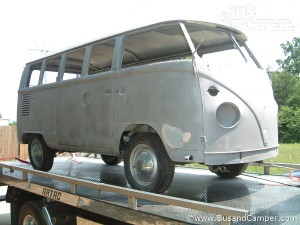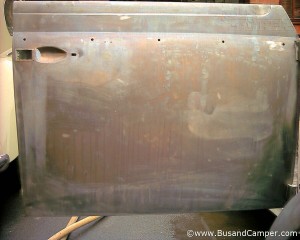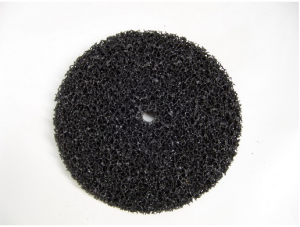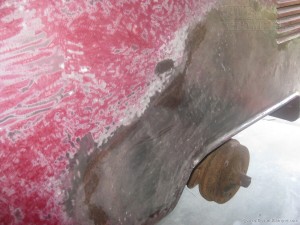Want to remove old paint ready for new – compare these methods.
Stripping paint – sand, soda and by hand methods compared
When the time comes to remove paint there are a number of different methods and techniques – all with varying results and costs. In a rough order of effectiveness the following can be employed / used / tried.
Sand blasting
Using sand to literally blast the paint off the surface of the steel is traditional and effective, it easily cuts through old layers of paint and helps remove rust flakes and surface corrosion. It will helpfully leave bondo or filler as the sand bounces off that type of surface. There are, however, drawbacks in that if used aggressively on the longer panels, like those on the drivers side of buses, the sand can generate significant amounts of heat and warp the panel slightly – if this happens there is no way back but to replace the warped material.
Sand blasting also gets sand everywhere – down vents, inside chassis tubes and rocker sill panels. It is ruthless in its ability to discover thin or thinning material – a thin section can be punched through unnecessarily with the sand. Expect to spend some money with a professional using this process – there is considerable health and safety regulations with sand blasting.
This is our VW bus 67 13w immediately after sand blasting:

Note how the small piece of bondo / filler on the front door has been left intact – this will need digging out by hand in case there is anything to fix behind it or at the very least to use more modern no shrink filler / bondo in there. Lead loading would be an ultimate fix for that area but to be honest modern filler materials are so advanced now in their no shrink properties that lead loading or filling is not really worth the time and effort – imho.
Soda blasting
Relative to sand, soda blasting is a new process – it uses the same basic principle of compressed air to deliver a small focused amount of media to the surface, the baking soda crystals exploding on impact and removing the paint with it. There is a science to the crystal structure to be used and there is a small network of professionals that would probably advise on the material – but whatever they select the core product is very close to baking soda.
One good advantage to using baking soda is that it merely washes off, so if you can rotate or tilt the bus then washing the soda out of the various sections works better than trying to flush sand out – baking soda dissolves in water. Probably not as expensive or risky as sand blasting, this process would be ideal if you could find a nearby professional. We tried the door in a brick built garage in Milton Keynes – one big white powdery mess – but we get the desired result and importantly no flash rust despite being left for about 3-4 weeks before painting.
If there is a drawback to this method its the same for sand blasting – the compressed air delivery method gets the soda everywhere – heater tubes, chassis rails,etc and no matter how well you think you’ve plugged those holes expect the white powder to get in those nooks and crannies.
This is a VW Bug door that we tried the soda blasting on:

The door was blasted and then washed with water, note the lack of flash rust which would have been almost immediate if we’d used sand. Those wipe marks were revealed after soda blasting and were there on the door under the paint – in other words from the VW factory.
By Hand with an Electric drill
As the name suggests this method is labour intensive – it takes time, expect to spend at least a couple of weekends stripping paint. The better tool for this is an electric drill and lots of paint strip wheels – not the wire brush or sand paper style but the wheels with 3M style scotch brite material.
This is what the generic product looks like:

This is a Bus long panel with some of its paint removed using this method:

The wheel quickly stripped off the paint but was not harsh enough to remove or mark the steel underneath. Its also really good at removing bondo or filler. Sharp edges will shred the material real quick so avoid those rusty areas. Wear a mask and more importantly eye protection. The above panel around the wheelarch was about 4-10mm thick with bondo / filler and some creative shaping.
Chemical removal – Nitromors or equivalent
Quick and effective, paint the surface with the chemical and then watch the paint bubble up and crinkle as it literally detaches itself from the surface of the steel. I dislike this method as the fumes are incredible and the by product is a chemically loaded gunge that if it gets on your skin kind of stings.
Technorati Y7BKSRBCBJNW